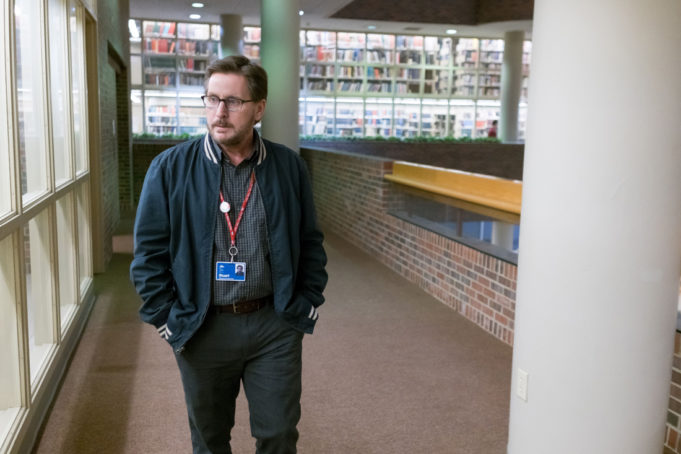In less than a month, I will have my Master’s in Library Science — a degree that will let me explore preservation as well as restoration, two parts of a career I have a deep passion for. For the last 12 years, I have been writing about movies, sometimes for a living, sometimes not. So when offered to review a movie about the library system written and directed by (as well as starring) one of my favorite actors, I jumped at the opportunity. I wanted to see how much research he put into this film. So how accurate is Emilio Estevez’s portrayal of the library system in his new film, The Public? The answer: very.
Estevez stars as Stuart Goodson, the senior librarian and manager of the Cincinnati Library. Temperatures are below freezing, and the local homeless community (including the always-great Michael K. Williams) are seeking refuge inside during library hours. It’s not a problem until one night when they refuse to leave because too many comrades have died trying to survive the cold. Goodson decides to let them stay, but a good story needs a villain, and here it’s a reporter (Gabrielle Union) who digs up Goodson’s past and spins the story so that he’s immediately accused of holding the homeless hostage. It turns out there are good reasons why people believe this to be true.
The Public is a taut, solid movie that accurately portrays the library system, mental illness, and doing the right thing. Everyone who walks through the library doors is welcome to come in to avoid the biting cold or blistering heat, play on the computers, read books, and do everything else a patron does when coming to the library. This makes the place a haven for the homeless, a lot of whom are mentally ill, though most of them are not dangerous. The movie wants to break the stigma of mental illness and does a heartwarming, successful job doing it.
There aren’t many good films about libraries. The Pagemaster starring Macaulay Culkin was once a masterpiece, but I’m not 8 anymore. The closest exceptional film about libraries we’ve had is the mesmerizing three-hour (!!!) documentary Ex Libris: The New York Library. The Breakfast Club, of course, is a classic set in a library (and starring Estevez), but it’s not about a library. Now, we finally have a superb fictional film enveloping real, everyday life at one of these institutions. The Public may be a small film with an impressive cast (Jeffrey Wright! Christian Slater! Alec Baldwin! Ones I already mentioned!), but it wears its big, beating heart on its sleeve.
Throughout the movie, the camera cuts to a statue of an isolated polar bear (an animal that lives in cold temperatures) that’s not supposed to be there but “takes refuge” because the local museum didn’t have room for it and needed the library space. The bear is a subtle metaphor for homeless who take shelter in a library because of the weather and their limited places to go.
Estevez is known for acting, but he has been directing movies since the tender age of 24 (1986’s Wisdom, co-starring Demi Moore). His efforts behind the camera have grown steadily more serious. His previous film, The Way, is an excellent journey of finding yourself. With The Public, it is about showing truths, some ugly, and some with a bright sunshiny day at the end of the tunnel, just like this movie.
Starring Emilio Estevez and Gabrielle Union. Written and directed by Emilio Estevez. Rated PG-13.













—-The movie wants to break the stigma of mental illness and does a heartwarming, successful job doing it.
Ok, you have been trained to say mental illnesses carry a stigma. Now what?
Hi Harold,
Thanks for your response.
I have read all of your comments on Facebook, where you crusade about how saying there’s a stigma to mental illness is a bad thing. I respect your opinion (and disagree), but it’s just that, your opinion.
As someone who suffers from mental illness, I can tell you firsthand that people do judge, and people assume negative things that are not remotely true.
There is a stigma to mental illness and it needs to be shattered so the topic needs to be brought to light in an objective way in movies, and it’s often not (except here that comes to memory). I wrote more about it, but it got cut. That said, people often assume people with mental illness are dangerous, and that’s not true. Most’s go-to regarding someone who did something very evil like shoot up a school “must be mentally ill,” so yes, there is a stigma to mental illness. Not all who deal with mental illness want to harm others.
And there’s a stigma that all homeless people are mentally ill. That is not true. Sure, some battle mental illness, but that does not mean they are dangerous.
You haven’t seen the movie yet because it has not been released, so perhaps it is best to wait until you do that before you continue your crusade on commenting here (Did you even like my lighthearted joke about Pagemaster? I am proud of that one.), but continue to do your thing on every article you find online that says there’s a stigma to mental illness, which is what you seem to be doing.
I’ll say it one more time to bring it home — most people have mental illness in some way, and it’s often looked at in a cold, shameful way, which is what stigma is. A lot of homeless are mentally ill but cannot get the proper care as someone with health insurance can. But just because someone is homeless and mentally ill, it does not mean they are dangerous, which THE PUBLIC wonderfully displays. It shows that it’s OK to hurt and suffer but do your best to be kind to others and be kind to yourself.
I respect your opinion, now respect mine.